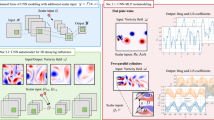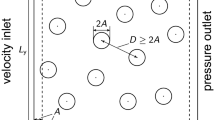Abstract
Flow around a circular cylinder is ubiquitous in nature and industrial applications. In marine, coastal and bridge engineering, undesirable vortex-induced vibrations (VIVs) of structural components are common, and the periodic vortex shedding (von K\(\acute{a}\)rmen vortex streets) of the cylinder plays a crucial role in the VIVs. Therefore, it makes sense to consider approaches to suppress vortex shedding and improve the surrounding flow of the cylinder. Two categories of flow control methods, i.e., passive and active strategies, effectively handled this problem. Compared to active control, the passive control method does not require additional energy input to maintain the process and is easier and more cost-effective to implement, making it worth investigating. This selective literature review gives academic frontiers on passive control of flow past a circular cylinder, including splitter plate, groove, screen, rough surfaces, spirals and helical plates, slit passive jets, control rods, porous media coating and vortex generators. Finally, we give a brief outlook on the application of machine deep learning methods in the passive control of flow around a circular cylinder.
Graphical abstract































































Similar content being viewed by others
References
Achenbach E (1971) Influence of surface roughness on the cross-flow around a circular cylinder. J Fluid Mech 46:321–335
Apelt C, West G (1975) The effects of wake splitter plates on bluff-body flow in the range 104¡ r¡ 5\(\times\) 104. part 2. J Fluid Mech 71:145–160
Apelt C, West G, Szewczyk AA (1973) The effects of wake splitter plates on the flow past a circular cylinder in the range 104¡ r¡ 5\(\times\) 104. J Fluid Mech 61:187–198
Arcondoulis E, Ragni D, Rubio Carpio A, Avallone F, Liu Y, Yang Y, Li Z, (2019)a The internal and external flow fields of a structured porous coated cylinder and implications on flow-induced noise. In: 25th AIAA/CEAS aeroacoustics conference, p. 2648
Arcondoulis EJ, Geyer TF, Liu Y (2021) An investigation of wake flows produced by asymmetrically structured porous coated cylinders. Phys Fluids 33:037124
Arcondoulis EJ, Liu Y, Li Z, Yang Y, Wang Y (2019) Structured porous material design for passive flow and noise control of cylinders in uniform flow. Materials 12:2905
Assi GR, Bearman P, Kitney N (2009) Low drag solutions for suppressing vortex-induced vibration of circular cylinders. J Fluids Struct 25:666–675
Baek H, Karniadakis GE (2009) Suppressing vortex-induced vibrations via passive means. J Fluids Struct 25:848–866
Bearman P, Harvey J (1976) Golf ball aerodynamics. Aeronaut Q 27:112–122
Bearman PW (1984) Vortex shedding from oscillating bluff bodies. Annu Rev Fluid Mech 16:195–222
Bearman PW, Tombazis N (1993) The effects of three-dimensional imposed disturbances on bluff body near wake flows. J Wind Eng Ind Aerodyn 49:339–349
Bernitsas MM, Raghavan K, Ben-Simon Y, Garcia E (2008) Vivace (vortex induced vibration aquatic clean energy): a new concept in generation of clean and renewable energy from fluid flow. J Offshore Mech Arct Eng 130
Butt U, Jehring L, Egbers C (2014) Mechanism of drag reduction for circular cylinders with patterned surface. Int J Heat Fluid Flow 45:128–134
Chen W, Li H, Ou J, Li F (2011) Field monitoring of vortex induced vibration of stay cables of cable-stayed bridge. In: proceedings of the 9th international symposium on cable dynamics, Shanghai, China, pp. 257–264
Chen WL, Gao D, Laima S, Li H (2019) A field investigation on vortex-induced vibrations of stay cables in a cable-stayed bridge. Appl Sci 9:4556
Chen WL, Gao DL, Yuan WY, Li H, Hu H (2015) Passive jet control of flow around a circular cylinder. Exp Fluids 56:1–15
Choi H, Jeon WP, Kim J (2008) Control of flow over a bluff body. Annu Rev Fluid Mech 40:113–139
Cimbala JM, Garg S (1991) Flow in the wake of a freely rotatable cylinder with splitter plate. AIAA J 29:1001–1003
Ding L, Bernitsas MM, Kim ES (2013) 2-d urans vs. experiments of flow induced motions of two circular cylinders in tandem with passive turbulence control for 30,000< re< 105,000. Ocean Eng 72:429–440
Dong S, Triantafyllou G, Karniadakis G (2008) Elimination of vortex streets in bluff-body flows. Phys Rev Lett 100:204501
Durhasan T, Pinar E, Ozkan G, Akilli H, Sahin B (2019) The effect of shroud on vortex shedding mechanism of cylinder. Appl Ocean Res 84:51–61
Fouatih OM, Medale M, Imine O, Imine B (2016) Design optimization of the aerodynamic passive flow control on naca 4415 airfoil using vortex generators. Eur J Mech-B/Fluids 56:82–96
Gao D, Chang X, Tursuntohti T, Yu H, Chen WL (2022) Modification of subcritical cylinder flow with an upstream rod. Phys Fluids 34:015107
Gao D, Chen WL, Zhang RT, Huang YW, Li H (2019) Multi-modal vortex-and rain-wind-induced vibrations of an inclined flexible cable. Mech Syst Signal Process 118:245–258
Gao D, Huang Y, Chen WL, Chen G, Li H (2019) Control of circular cylinder flow via bilateral splitter plates. Phys Fluids 31:057105
Gao DL, Chen WL, Li H, Hu H (2017) Flow around a circular cylinder with slit. Exp Thermal Fluid Sci 82:287–301
Gao DL, Chen WL, Li H, Hu H (2017) Flow around a slotted circular cylinder at various angles of attack. Exp Fluids 58:1–15
Gao Y, Yang J, Xiong Y, Wang M, Peng G (2016) Experimental investigation of the effects of the coverage of helical strakes on the vortex-induced vibration response of a flexible riser. Appl Ocean Res 59:53–64
Hiwada M, Taguchi T, Mabuichi I, Kumada M (1979) Fluid flow and heat transfer around two circular cylinders of different diameters in cross flow. Bull JSME 22:715–723
Huang S, Clelland D, Day S, James R, (2007) Drag reduction of deepwater risers by the use of helical grooves. In: international conference on offshore mechanics and arctic engineering, pp. 561–565
Kimura T, Tsutahara M (1991) Fluid dynamic effects of grooves on circular cylinder surface. AIAA J 29:2062–2068
Korkischko I, Meneghini J (2010) Experimental investigation of flow-induced vibration on isolated and tandem circular cylinders fitted with strakes. J Fluids Struct 26:611–625
Kwon K, Choi H (1996) Control of laminar vortex shedding behind a circular cylinder using splitter plates. Phys Fluids 8:479–486
Law Y, Jaiman R (2018) Passive control of vortex-induced vibration by spanwise grooves. J Fluids Struct 83:1–26
Lee SJ, Lee SI, Park CW (2004) Reducing the drag on a circular cylinder by upstream installation of a small control rod. Fluid Dyn Res 34:233
Li J, Zhang M, Martins JR, Shu C (2020) Efficient aerodynamic shape optimization with deep-learning-based geometric filtering. AIAA J 58:4243–4259
Li Z, Tang T, Liu Y, Arcondoulis EJ, Yang Y (2020) Numerical study of aerodynamic and aeroacoustic characteristics of flow over porous coated cylinders: effects of porous properties. Aerosp Sci Technol 105:106042
Lin JC (2002) Review of research on low-profile vortex generators to control boundary-layer separation. Prog Aerosp Sci 38:389–420
Liu H, Wei J, Qu Z (2012) Prediction of aerodynamic noise reduction by using open-cell metal foam. J Sound Vib 331:1483–1497
Ma LQ, Feng LH (2019) Vortex formation and evolution for flow over a circular cylinder excited by symmetric synthetic jets. Exp Thermal Fluid Sci 104:89–104
Matsumoto M, Yagi T, Hatsuda H, Shima T, Tanaka M, Naito H (2010) Dry galloping characteristics and its mechanism of inclined/yawed cables. J Wind Eng Ind Aerodyn 98:317–327
Naumann A (1966) The conditions of separation and vortex formation past cylinders. In: AGARD conference proceedings no. 4, Separated Flows
Oruc V (2012) Passive control of flow structures around a circular cylinder by using screen. J Fluids Struct 33:229–242
Ozkan GM, Firat E, Akilli H (2017) Passive flow control in the near wake of a circular cylinder using attached permeable and inclined short plates. Ocean Eng 134:35–49
Park H, Bernitsas MM, Ajith KR (2012) Selective roughness in the boundary layer to suppress flow-induced motions of circular cylinder at 30,000< re< 120,000. J Offshore Mechanics Arctic Eng 134
Park H, Bernitsas MM, Chang CC (2013) Map of passive turbulence control to flow-induced motions for a circular cylinder at 30,000< re< 120,000: sensitivity to zone covering. In: international conference on offshore mechanics and arctic engineering, American Society of Mechanical Engineers. p. V007T08A003
Rashidi S, Hayatdavoodi M, Esfahani JA (2016) Vortex shedding suppression and wake control: a review. Ocean Eng 126:57–80
Reddy G, Celani A, Sejnowski TJ, Vergassola M (2016) Learning to soar in turbulent environments. Proc Natl Acad Sci 113:E4877–E4884
Roshko A (1955) On the wake and drag of bluff bodies. J Aeronaut Sci 22:124–132
Sarpkaya T (2004) A critical review of the intrinsic nature of vortex-induced vibrations. J Fluids Struct 19:389–447
Shukla S, Govardhan R, Arakeri J (2013) Dynamics of a flexible splitter plate in the wake of a circular cylinder. J Fluids Struct 41:127–134
Singh N (2019) Control of laminar separation bubble using vortex generators. J Appl Fluid Mech 12:891–905
Strykowski PJ, Sreenivasan KR (1990) On the formation and suppression of vortex ‘shedding’ low reynolds numbers. J Fluid Mech 218: 71–107
Sumer B.M, Fredsøe J (1997) Hydrodynamics around cylindrical structures, pp. xviii+ 530
Taylor H (1947) The elimination of diffuser separation by vortex generators research department report no. r-4012-3 united aircraft corporation. East Hartford, Connecticut
Tombazis N, Bearman P (1997) A study of three-dimensional aspects of vortex shedding from a bluff body with a mild geometric disturbance. J Fluid Mech 330:85–112
Ünal UO, Gören Ö (2011) Effect of vortex generators on the flow around a circular cylinder: computational investigation with two-equation turbulence models. Eng Appl Comput Fluid Mech 5:99–116
Viquerat J, Rabault J, Kuhnle A, Ghraieb H, Larcher A, Hachem E (2021) Direct shape optimization through deep reinforcement learning. J Comput Phys 428:110080
Williamson CH, Govardhan R (2004) Vortex-induced vibrations. Annu Rev Fluid Mech 36:413–455
Wu J, Shu C, Zhao N (2014) Numerical investigation of vortex-induced vibration of a circular cylinder with a hinged flat plate. Phys Fluids 26:063601
Xin ZQ, Wu ZH, Wu CJ, Huang D (2020) Control of vortex-induced vibrations of the cylinder by using split-ter plates immersed in the cylinder wake at low reynolds number. J Hydrodyn 32:942–952
Xu M, Song S, Sun X, Chen W, Zhang W (2021) Machine learning for adjoint vector in aerodynamic shape optimization. Acta Mechanica Sinica , 1–17
Xu Z, Chang X, Yu H, Chen W.L, Gao D, (2022) Structured porous surface for drag reduction and wake attenuation of cylinder flow. Ocean Eng, 110444
Yan X, Zhu J, Kuang M, Wang X (2019) Aerodynamic shape optimization using a novel optimizer based on machine learning techniques. Aerosp Sci Technol 86:826–835
Yuan W, Laima S, Gao D, Chen WL, Li H (2021) Influence of porous media coatings on flow characteristics and vortex-induced vibration of circular cylinders. J Fluids Struct 106:103365
Zhou B, Wang X, Guo W, Gho WM, Tan SK (2015) Control of flow past a dimpled circular cylinder. Exp Thermal Fluid Sci 69:19–26
Zhou T, Razali SM, Hao Z, Cheng L (2011) On the study of vortex-induced vibration of a cylinder with helical strakes. J Fluids Struct 27:903–917
Zhu H, Liu W (2020) Flow control and vibration response of a circular cylinder attached with a wavy plate. Ocean Eng 212:107537
Zhu H, Yao J (2015) Numerical evaluation of passive control of viv by small control rods. Appl Ocean Res 51:93–116
Acknowledgements
We would like to acknowledge the financial supports from the National Natural Science Foundation of China (52008140, 51978222) and the Fundamental Research Funds for the Central Universities (2020AUGA5710001020).
Author information
Authors and Affiliations
Corresponding author
Additional information
Publisher's Note
Springer Nature remains neutral with regard to jurisdictional claims in published maps and institutional affiliations.
Rights and permissions
About this article
Cite this article
Ran, Y., Deng, Z., Yu, H. et al. Review of passive control of flow past a circular cylinder. J Vis 26, 1–44 (2023). https://doi.org/10.1007/s12650-022-00858-3
Received:
Revised:
Accepted:
Published:
Issue Date:
DOI: https://doi.org/10.1007/s12650-022-00858-3




